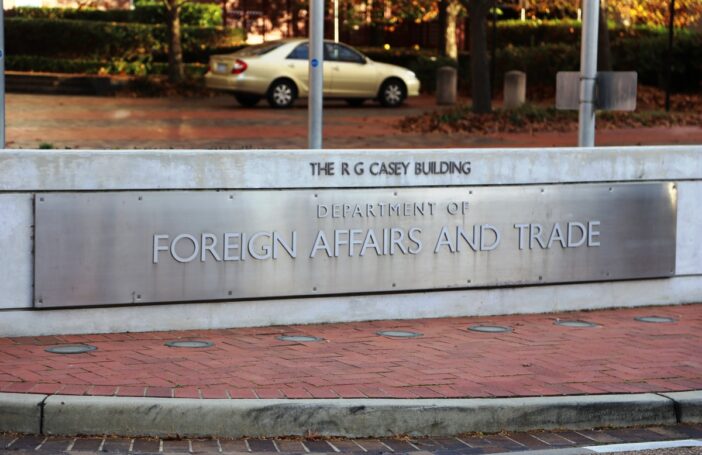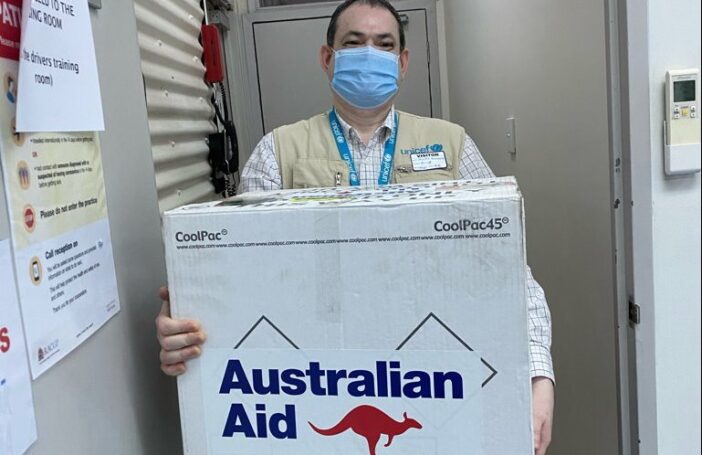In September 2013, there was intense media and public interest in the incoming Abbott government’s decision—one of its first—to abolish the Australian Agency for International Development (AusAID) and transfer its functions and resources to the Department of Foreign Affairs and Trade (DFAT). Surprisingly intense interest, in fact, but also quick to fade.
In the little over a year that has passed since then, DFAT has transmitted over 140,000 diplomatic cables at a rate of about 36 per officer per annum, supported some 130 overseas visits by ministers, parliamentarians and other potentates, issued about 1.8 million passports, assisted enough Australians in difficulty overseas to fill the Rod Laver Arena, and, with considerable athleticism, ‘reshaped’ Australia’s $5 billion aid program. This week, DFAT is celebrating 40 years of Australian aid—dating this anniversary, ironically, from the creation in legislation of Australia’s first independent development assistance agency under the Whitlam Labor government.
Though the media has moved on, the ‘under new management’ shingle has been taken down and Senate Estimates hearings continue to dwell on whatever is in the newspapers on sitting days, it seems timely, and at last possible, to look at what impact last year’s ‘machinery of government’ change actually had on the aid program and its administration. DFAT’s 2013-14 Annual Report (the source of the facts above) has recently been released and this, together with morcels of information from various other sources, provides at least a partial view of the situation.
That partial view is described below under three headings: aid volume and allocation, staffing reductions, and organisational structure. The emphasis here is on the broad management of aid resources up to around mid-2014; it is too soon to say much about the implementation of an aid policy released only in June 2014, or to generalise from the few significant aid allocation decisions made to date.
Aid volume and allocation
We can now be sure from the Annual Report that the 2013-14 aid budget was expended in full and almost exactly in line with the 2013-14 outcome estimates provided in May, at the time of the 2014-15 budget. This was not to be taken for granted given that the aid budget suffered a mid-year cut of $650 million in September 2013, that the cuts were not allocated to programs until January 2014, and that the agency responsible for delivering the budget was abolished and its staff told that an unspecified number of them would lose their jobs. The merger of AusAID’s Canadian equivalent into Canada’s foreign ministry was reportedly followed by, and presumably led to, substantial under-expenditure in Canada’s aid program.
If one simply deletes from history Labor’s $5.7 billion aid budget for the 2013-14 financial year, and compares Labor’s 2012-13 aid spending outcome with the Coalition’s 2013-14 outcome, as presented in DFAT’s Annual Report, the changes are for the most part not dramatic. The spending outcomes for major Official Development Assistance (ODA) program components are shown in the chart below, with percentage changes for each component in green.
Australian ODA expenditure outcomes, 2012-13 and 2013-14
 Overall, aid fell by $117 million or 2.3 per cent in nominal terms from 2012-13 to 2013‑14 (a real cut of just over 5 per cent), though the amount of aid managed by DFAT in 2013-14 was the same in nominal terms as the amount managed by AusAID in 2012-13, namely $4.3 billion. Funding for programs was reduced by $298 million in gross terms, with by far the largest reduction ($142 million) experienced by programs in sub-Saharan Africa—though there is at present no way of knowing which programs or with what consequences. Of this gross amount, $144 million was redistributed rather than saved, mostly and in about equal measure to East Asia and global programs.
Overall, aid fell by $117 million or 2.3 per cent in nominal terms from 2012-13 to 2013‑14 (a real cut of just over 5 per cent), though the amount of aid managed by DFAT in 2013-14 was the same in nominal terms as the amount managed by AusAID in 2012-13, namely $4.3 billion. Funding for programs was reduced by $298 million in gross terms, with by far the largest reduction ($142 million) experienced by programs in sub-Saharan Africa—though there is at present no way of knowing which programs or with what consequences. Of this gross amount, $144 million was redistributed rather than saved, mostly and in about equal measure to East Asia and global programs.
‘Departmental’ spending, which is DFAT’s spending on personnel and other administrative costs associated with running the aid program—its aid program support budget—rose from $326 million in 2012-13 to $373 million in 2013-14. This was almost exactly in line with the increase originally planned by Labor in the context of its $5.7 billion budget. A departmental spending increase of this magnitude was in fact flagged in May, in the 2014-15 budget papers, and is unsurprising given that savings achieved through staffing cuts in 2013-14 are likely to have been approximately offset by the cost of voluntary redundancy packages.
Expenditure by government departments other than DFAT in 2013-14 was $735 million, down 13 per cent in nominal terms from 2012-13. The lion’s share of this was consumed by the Department of Immigration and Border Protection (DIBP), which in each of 2012‑13 and 2013‑14 was allocated $375 million from the aid budget to offset costs associated with the presence of asylum-seekers in the Australian community. It remains entirely unknown whether this funding, totaling $750 million, was in fact expended for the intended purposes, and how, by whom and to whom, this spending might have been accounted for. The former Secretary of DIBP appeared to take the view that the transfer of funds was a book-keeping manoeuvre on the part of the Department of Finance, requiring no accounting on his department’s part. Perhaps he was quite right about that—but he also flagged that DIBP might not actually spend as much as the Department of Finance had assumed. The OECD, as custodian of the rules about what counts as overseas aid, might be expected to display an interest in this subject when next it conducts a peer review of Australia’s aid program.
Staffing reductions
There was extended uncertainty on all sides about the number of staff to be shed as a result of the integration of AusAID into DFAT, persisting for some eight months until the 2014‑15 budget. A leaked DFAT staff survey conducted toward the peak of uncertainty, in February and March of this year, revealed unsurprisingly high levels of dissatisfaction and disengagement among former AusAID staff. Some observers were inclined to diagnose culture shock, but job insecurity can hardly have been a small factor. In the May budget, finally, DFAT’s aid program support budget allocation was set at $251 million, in line with a new rule stated in Budget Paper No. 2 that caps aid program support costs at five per cent of total aid. In 2013-14, support costs had reached 7.4 per cent, up from 6.5 per cent the previous year. (DFAT must have been relieved that the denominator used for the five per cent rule was taken as total rather than DFAT-managed ODA. The actual articulation of the rule was at best ambiguous on this point, referring to ‘DFAT’s total ODA budget’.)
We learned from testimony to Senate Estimates hearings in June and October of this year that, based on the above aid program support allocation, DFAT saw a need to reduce its staffing complement by about 500 positions by mid-2015, with most positions to be taken from ex-AusAID units whose staffing totaled 1,724 just before integration. This suggested that the incremental cost of a position, salary plus overheads, was calculated to be on average around $240,000 per annum, about twice a mid-ranking public servant’s salary. Thus a cut in the aid program support budget of $122 million translated into a cut of 500 positions. This was broadly as anticipated—a 30 per cent cut in staff numbers relative to the cancellation of a roughly 35 per cent nominal increase in the size of the aid program over the next few years. It should be noted that if the five per cent cap had been applied to DFAT-managed ODA only, which was $4.3 million, DFAT’s aid program support allocation would have been $36 million lower, necessitating the shedding of up to 150 more positions.
From DFAT’s Annual Report we now also know that the total number of DFAT staff as at mid-2014 (3,950) was 280 below the combined number of staff in DFAT and AusAID just before integration (2,506 and 1,724, respectively). Most of the departed staff, as DFAT’s Secretary had forewarned, were from the former AusAID, including 13 of the 16 Senior Executive Service officers who have so far left.
So, while the 280 fall is a net one, it seems there might be roughly 220 more departures to come in the course of the present financial year. It is very difficult to see how DFAT could have entered the financial year with an aid program support budget one-third smaller than last year’s, yet be able to carry any significant proportion of these 220 or so remaining positions on its books, or indeed offer people in these positions voluntary redundancy packages. Even without costs associated with these latter packages, the five per cent cap on program support costs looks unrealistic. The cap itself is not unreasonable—administrative costs accounted for just over five per cent of all OECD aid in 2012, and over the long term the OECD average has been just under five per cent—but it does seem unreasonable to expect DFAT to bring such costs down from over seven per cent to five per cent in a single year.
Though the five per cent cap might be a pain in the short term, DFAT probably doesn’t mind it so much from a longer term perspective. Provided the aid program remains approximately constant, the cap is also a floor, guaranteeing around $250 million in aid funding each year for DFAT staffing and other expenses. Around half of this amount would normally be used for non-salary expenses, which in large part will provide a general benefit to the department rather than being confined to its aid delivery function. As for the salary component, nobody will ever know how the 1,200 or so people paid from it are actually using their time but it is a safe bet that many of them will be dividing it between aid-related and other matters.
Given the inevitable pressure to cannibalise aid program support funding, and the overall reduction in numbers, DFAT will need to ensure it has rather productive, skilled and ambidextrous people working on aid policy and management. The 2013-14 Annual Report, encouragingly, says that the department has initiated a workforce planning exercise to determine requirements for the next four years, which will build on existing efforts ‘to attract and retain specialist policy and program staff to deliver on the Government’s re-focused aid program’.
At this point, there has been no net reduction in the number of locally-engaged staff staff (LES) employed by DFAT. In fact, there has been a net gain of more than 20 positions from the time of the merger to mid-2014. DFAT and AusAID had a combined total of 2,425 LES employees before the merger (1,774 and 651, respectively), and DFAT had 2,451 as at mid-2014. This is not to say that LES formerly employed by AusAID—and formerly designated as ‘overseas-based’ staff to differentiate them from staff mostly employed in administrative roles with little hope of career progression—have not departed in significant numbers. Anecdotal evidence suggests that they have. But, somehow, the bottom line has increased. One possibility is that it includes vacancies, which might or might not be filled in time.
Organisational structure
After moving through at least two interim organisational structures, DFAT has settled on a structure in which there are four dedicated aid divisions sitting alongside 21 foreign policy and trade divisions, and two new governance bodies: an aid investment committee and a development policy committee. The aid divisions cover contracting and aid management, international development policy, multilateral development partnerships, and humanitarian assistance. The Office of Development Effectiveness, a branch, sits outside the divisional structure but reports to a deputy secretary rather than, as previously, the agency head. In addition, many aid-related functions, including all those related to the delivery of assistance to specific countries and regions, have been shuffled into existing DFAT divisions. DFAT’s current structure can be seen here, and AusAID’s just before integration here.
All four of DFAT’s aid divisions are headed by former AusAID division heads, overseen by a deputy secretary who was formerly one of three deputies in AusAID. However, only two former AusAID division heads occupy ‘mainstream’ DFAT roles—one is Chief Financial Officer and the other heads the public diplomacy division. It is unclear at what level and by whom the aid investment and development policy committees are chaired. This is in contrast to the situation in Canada’s Department of Foreign Affairs, Trade and Development (yep, ‘and Development’), where several former senior staff of the Canadian Agency for International Development were, at the time of its abolition, placed in positions central to Canada’s foreign policy interests. There are, however, indications that former AusAID staff at and below the branch-head level are considered competitive for Canberra- and overseas-based non-aid positions of considerable responsibility.
In sum, (a) the aid program was not exactly ‘reshaped’ from 2012-13 to 2013-14, though a new coat of paint was applied in mid-2014; (b) aid expenditure did not fall short in mid-2014, as it might well have; (c) the second half of the staffing-cut marathon looks likely to be more painful than the first, though at least the location of the finish-line is known; (d) DFAT has recognised and is acting on the need to attract and retain multi-use and specialised staff; and (e) DFAT’s post-integration structure, while more thoroughgoing than it had good reason to be, does appear to give due weight to most core aid management functions.
However, there are several points on which information is scarce or entirely absent. Whatever did become of the $750 million transferred to DIBP in 2012 and 2013, $375 million of which was counted toward the full-expenditure outcome in 2013-14? What programs were cut in sub-Saharan Africa, and with what consequences? How is coherence in aid policy and management, and rigour in the assessment of aid effectiveness, assured across a heavily shuffled agency? And how will DFAT account for the utilisation of the $250 million it receives in this and future years to run the aid program?
These questions won’t be in the newspapers at the time of the next Senate Estimates hearings in February 2015, but they would be worth asking.
Robin Davies is the Associate Director of the Development Policy Centre.






An interesting speech by Minister Bishop at the ‘celebration’ of 40 years of aid tonight. On the upside, there was genuine recognition of the achievements of Australian aid over time, and of the people who have contributed to it. On the downside was the graceless lack of acknowledgement of anyone from the other side of politics from the last 40 years – Spender, Hasluck, Howard got a mention but no Whitlam, Evans, Bilney, Rudd … Downer was mentioned for his opening of the bridge in Vietnam which he had vowed to stop when in opposition. The opening of the Thai-Lao bridge was mentioned though no mention of Keating. There were Ministerial quotes on the wall in large letters about the need for the aid program to be more entrepreneurial, echoing the piece in The Canberra Times last week with the Minister simultaneously urging aid staff to be less risk averse, while noting that she had shut down AusAID because it had lost (small amounts of) money from fraud. Mixed signals?